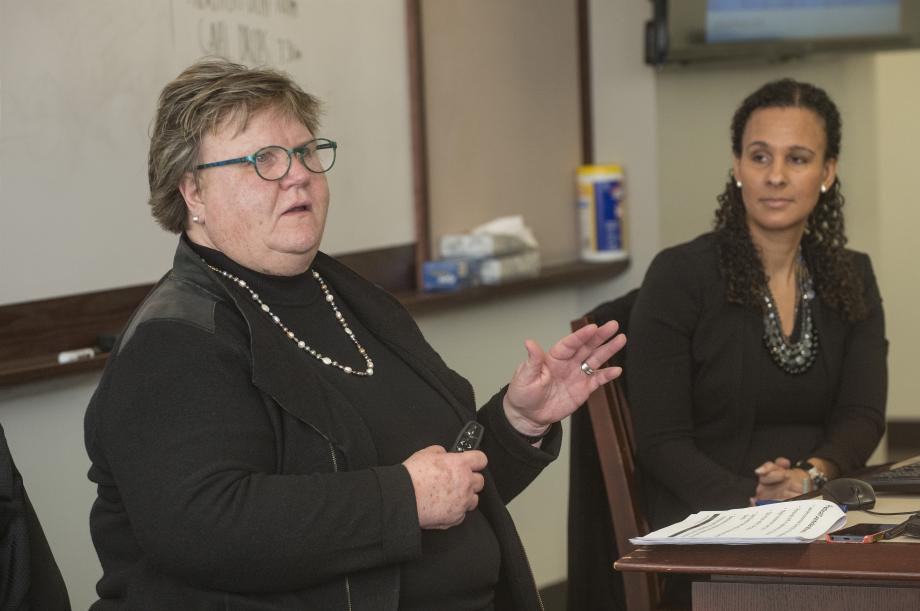Pushing the Legal Profession Forward

As advocates, lawyers must be be loyal to their clients and zealously represent them to the best of their abilities. But when a client’s wishes go against the profession’s standard to eliminate bias and accept inclusion, lawyers may find themselves in a difficult situation. These situations—and the American and Illinois State Bar Associations’ rules for managing them—were the subject of a Keystone presentation last month that brought experts on diversity and inclusion in the legal profession to the Law School.
The talk, Diversity & Discrimination as Legal Ethics Issues with Gail H. Morse and Lea S. Gutierrez, covered the evolution of misconduct rules in the legal profession and offered examples of managing discriminatory behavior in the workplace. It is essential that lawyers understand their obligations and know how to avoid discrimination, so this was a fitting topic for the Keystone Professionalism & Leadership Program—a program launched by the Office of the Dean of Students to teach students practical skills and prepare them for their careers. The subject is timely given the nationwide discussion about diversity and inclusion and the corresponding proposed amendments to the ABA’s rules on professional conduct.
The ABA Model Rule of Professional Conduct 8.4(d)—adopted by the Illinois Supreme Court in 2010—has language meant to address discriminatory conduct not in the text of the rule, but in a comment. Comments serve to guide a rule’s interpretation; however, as students learned during the presentation, comments hold little weight when compared to black-letter law.
“The comments are not authoritative and essentially have no effect,” said Morse, a partner at Jenner & Block and member of the firm’s Diversity & Inclusion Committee. “In my opinion, the ABA needs a black-letter rule—they shouldn’t be trying advance diversity and inclusion through comments.”
Though the Illinois Rules of Professional Conduct have a rule for addressing discrimination—namely, 8.4(j)—Gutierrez, Senior Litigation Counsel with the Attorney Registration & Discipline Commission (ARDC) and director of Diversity & Inclusion at the ARDC, explained that this rule is infrequently charged.
“This is a little bit misleading,” Gutierrez said. “It doesn’t mean that this conduct does not occur frequently, it’s just that there has to be a final and enforceable finding from a court in order to charge that rule.” Obtaining this final and enforceable finding can be extremely difficult.
A new proposal drafted just months ago would amend the ABA Model Rule 8.4(d) to add language about discrimination against protected classes, making lawyers who violate it subject to discipline. The amendment could very well change behavior, though it may take more to fully confront this problem.
“I can say from personal experience at the ARDC that some lawyers do understand that their behavior was inappropriate, but a lot of times they don’t,” Gutierrez said. “What they realize is that they can’t continue to do it—they don’t change their actual beliefs, they just change their conduct.”
There have been huge advances, but there is still more work to be done, Morse added.
“The ABA is trying to push the profession forward, and part of what the rules are supposed to do is to give lawyers some education around these issues and allow them to see that what they think may be zealous representation, or what they think may be appropriate behavior, really isn’t,” she said.
Morse and Gutierrez ended the presentation by asking students to think through a number of hypothetical situations. For example, if your client—a corporation accused of sex discrimination—asked you to staff their case with a female attorney solely to look better in front of the jury, what would you say?
One student argued that the client’s desire to have a woman on the bench may go beyond tokenism, saying that perhaps a female attorney should be staffed on a sex discrimination case so she can offer her opinion and diversity of experience. Morse agreed and said that discussing this distinction with the client would be good legal practice and could ultimately help the case.
“When you have pressures from clients like this, you should take it very seriously,” she said. “It’s a great opportunity to educate your client.”